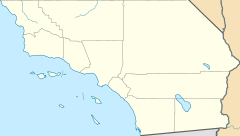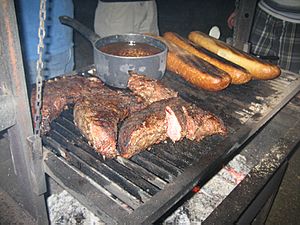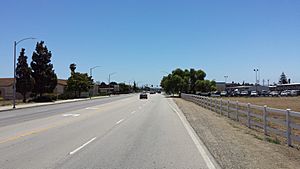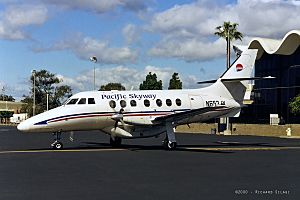Santa Maria, California facts for kids
Quick facts for kids
Santa Maria, California
|
||
|---|---|---|
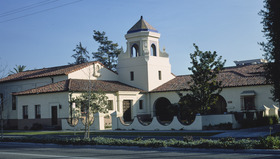
Santa Maria City Hall
|
||
|
||
| Nickname(s):
BBQ Capital of California
|
||
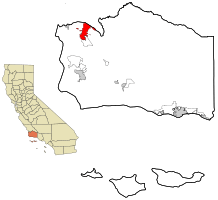
Location in Santa Barbara County and the state of California
|
||
| Country | ||
| State | ||
| County | ||
| Metro | Santa Maria-Santa Barbara | |
| Founded | 1874 | |
| Incorporated | September 12, 1905 | |
| Chartered | December 2000 | |
| Government | ||
| • Type | Council-manager | |
| Area | ||
| • City | 23.42 sq mi (60.65 km2) | |
| • Land | 22.81 sq mi (59.07 km2) | |
| • Water | 0.61 sq mi (1.58 km2) 2.73% | |
| • Metro | 2,735.09 sq mi (7,083.9 km2) | |
| Elevation | 217 ft (66 m) | |
| Population
(2020)
|
||
| • City | 109,707 | |
| • Estimate
(2021)
|
109,711 | |
| • Rank | 60th in California 282nd in the United States |
|
| • Density | 4,809.60/sq mi (1,857.24/km2) | |
| • Metro | 448,229 | |
| • Metro density | 163.8809/sq mi (63.27477/km2) | |
| Time zone | UTC−8 (Pacific) | |
| • Summer (DST) | UTC−7 (PDT) | |
| ZIP codes |
93454–93458
|
|
| Area code | 805 | |
| FIPS code | 06-69196 | |
| GNIS feature IDs | 1652791, 2411824 | |
Santa Maria is a city on the Central Coast of California. It is in northern Santa Barbara County. The city's name means "St. Mary" in Spanish.
Santa Maria is about 65 miles (105 km) northwest of Santa Barbara. It is also about 150 miles (240 km) northwest of downtown Los Angeles. In 2020, 109,707 people lived here. This makes it the largest city in Santa Barbara County. Santa Maria is famous for its wine and its special Santa Maria–style barbecue.
Contents
- Santa Maria's Past: A Look Back in Time
- Where is Santa Maria? Geography and Climate
- People of Santa Maria: Demographics
- Santa Maria's Economy: Jobs and Industries
- Fun and Culture in Santa Maria
- Parks and Recreation: Fun Outdoors
- Learning in Santa Maria: Schools and Colleges
- Media in Santa Maria
- Getting Around: Transportation in Santa Maria
- Law and Order in Santa Maria
- Famous People from Santa Maria
- Images for kids
- See also
Santa Maria's Past: A Look Back in Time
The Santa Maria Valley was once home to the Chumash people for thousands of years. These Native Americans lived near the Santa Maria River. They used special plank-built boats called Tomol for fishing in the ocean.
In 1769, the Portolá Expedition traveled through the valley. This was the first Spanish land exploration along the California coast. Later, in 1821, the land became available for private ownership. This happened after the Mexican War of Independence. The area was known as Rancho Punta de Laguna.
After the Mexican–American War in 1848, California became part of the United States. It became a state in 1850.
In the late 1800s, many farmers came to the area because of its rich soil. The Santa Maria River Valley soon became a very productive farming region. Farming is still a big part of the city's economy today.
The town of Santa Maria started between 1869 and 1874. Four settlers built their homes near what is now Broadway and Main Street. The town was first called Grangerville, then Central City. It changed to Santa Maria in 1885. This was because mail often went to Central City, Colorado, by mistake. The name Santa Maria came from a property name given by Juan Pacifico Ontiveros.
Oil was discovered in the area starting in 1888. Big oil fields were found in the early 1900s. This led to a lot of growth for the city. By 1957, there were many oil wells in the Santa Maria Valley.
Where is Santa Maria? Geography and Climate
Santa Maria covers about 22.4 square miles (58 square km). Most of this area is land. The city is north of Orcutt and south of the Santa Maria River. This river forms the border between Santa Barbara County and San Luis Obispo County.
The Pacific Ocean is to the west of the valley. The San Rafael Mountains and Los Padres National Forest are to the east. The city of Guadalupe, California is about 9 miles (14 km) west of Santa Maria.
Santa Maria's Weather: A Mediterranean Climate
Santa Maria has a cool Mediterranean climate. This means it has mild, wet winters and warm, dry summers. The weather is usually sunny, with cool ocean breezes. Fog is common, especially in the mornings.
Snow is very rare in the city itself. It has only been recorded a few times. The average rainfall is about 13.32 inches (338 mm) per year. However, the amount of rain can change a lot from year to year.
The hottest temperature ever recorded was 110 °F (43 °C) in June 2008. The coldest was 20 °F (−7 °C) in January 1976 and December 1978.
| Climate data for Santa Maria Public Airport, California (1991–2020, extremes 1948–present) | |||||||||||||
|---|---|---|---|---|---|---|---|---|---|---|---|---|---|
| Month | Jan | Feb | Mar | Apr | May | Jun | Jul | Aug | Sep | Oct | Nov | Dec | Year |
| Record high °F (°C) | 89 (32) |
89 (32) |
95 (35) |
103 (39) |
105 (41) |
110 (43) |
104 (40) |
104 (40) |
106 (41) |
108 (42) |
96 (36) |
90 (32) |
110 (43) |
| Mean maximum °F (°C) | 77.2 (25.1) |
79.1 (26.2) |
79.8 (26.6) |
85.4 (29.7) |
84.1 (28.9) |
85.2 (29.6) |
85.6 (29.8) |
85.5 (29.7) |
90.1 (32.3) |
91.8 (33.2) |
84.4 (29.1) |
76.2 (24.6) |
96.9 (36.1) |
| Mean daily maximum °F (°C) | 64.7 (18.2) |
64.8 (18.2) |
66.3 (19.1) |
68.1 (20.1) |
69.3 (20.7) |
71.3 (21.8) |
73.3 (22.9) |
73.8 (23.2) |
75.0 (23.9) |
74.6 (23.7) |
70.0 (21.1) |
64.3 (17.9) |
69.6 (20.9) |
| Daily mean °F (°C) | 52.8 (11.6) |
53.6 (12.0) |
55.3 (12.9) |
56.7 (13.7) |
59.0 (15.0) |
61.5 (16.4) |
64.1 (17.8) |
64.5 (18.1) |
64.3 (17.9) |
62.2 (16.8) |
57.1 (13.9) |
52.2 (11.2) |
58.6 (14.8) |
| Mean daily minimum °F (°C) | 41.0 (5.0) |
42.5 (5.8) |
44.3 (6.8) |
45.4 (7.4) |
48.7 (9.3) |
51.6 (10.9) |
53.8 (12.1) |
54.2 (12.3) |
53.7 (12.1) |
49.8 (9.9) |
44.3 (6.8) |
40.1 (4.5) |
47.4 (8.6) |
| Mean minimum °F (°C) | 29.8 (−1.2) |
31.3 (−0.4) |
34.2 (1.2) |
35.5 (1.9) |
39.7 (4.3) |
43.8 (6.6) |
48.6 (9.2) |
48.7 (9.3) |
45.9 (7.7) |
40.1 (4.5) |
33.1 (0.6) |
28.7 (−1.8) |
27.1 (−2.7) |
| Record low °F (°C) | 20 (−7) |
22 (−6) |
24 (−4) |
28 (−2) |
27 (−3) |
35 (2) |
41 (5) |
40 (4) |
32 (0) |
26 (−3) |
21 (−6) |
20 (−7) |
20 (−7) |
| Average precipitation inches (mm) | 2.74 (70) |
2.85 (72) |
2.56 (65) |
0.93 (24) |
0.36 (9.1) |
0.06 (1.5) |
0.03 (0.76) |
0.01 (0.25) |
0.07 (1.8) |
0.54 (14) |
1.12 (28) |
2.05 (52) |
13.32 (338) |
| Average precipitation days (≥ 0.01 in) | 7.7 | 8.7 | 8.1 | 4.3 | 1.6 | 0.6 | 0.4 | 0.5 | 1.1 | 3.0 | 5.2 | 6.9 | 48.1 |
| Average relative humidity (%) | 65.4 | 72.7 | 75.7 | 75.6 | 78.9 | 79.3 | 81.2 | 79.9 | 80.5 | 74.7 | 71.3 | 70.8 | 75.5 |
| Source: NOAA (relative humidity 1961–1990) | |||||||||||||
People of Santa Maria: Demographics
| Historical population | |||
|---|---|---|---|
| Census | Pop. | %± | |
| 1910 | 2,260 | — | |
| 1920 | 3,943 | 74.5% | |
| 1930 | 7,057 | 79.0% | |
| 1940 | 8,522 | 20.8% | |
| 1950 | 10,440 | 22.5% | |
| 1960 | 20,027 | 91.8% | |
| 1970 | 32,749 | 63.5% | |
| 1980 | 39,685 | 21.2% | |
| 1990 | 61,284 | 54.4% | |
| 2000 | 77,423 | 26.3% | |
| 2010 | 99,553 | 28.6% | |
| 2020 | 109,707 | 10.2% | |
| U.S. Decennial Census | |||
In 2020, Santa Maria had a population of 109,707 people. The city is very diverse. Many different groups of people live here.
Population Details from 2020
| Race / Ethnicity (NH = Non-Hispanic) | Pop 2000 | Pop 2010 | Pop 2020 | % 2000 | % 2010 | % 2020 |
|---|---|---|---|---|---|---|
| White alone (NH) | 24,742 | 21,626 | 16,758 | 31.96% | 21.72% | 15.28% |
| Black or African American alone (NH) | 1,246 | 1,193 | 1,043 | 1.61% | 1.20% | 0.95% |
| Native American or Alaska Native alone (NH) | 390 | 345 | 322 | 0.29% | 0.35% | 0.29% |
| Asian alone (NH) | 3,406 | 4,652 | 4,999 | 4.40% | 4.67% | 4.56% |
| Pacific Islander alone (NH) | 109 | 132 | 96 | 0.14% | 0.13% | 0.09% |
| Other Race alone (NH) | 68 | 157 | 504 | 0.09% | 0.16% | 0.46% |
| Mixed race or Multiracial (NH) | 1,266 | 1,334 | 2,017 | 1.64% | 1.34% | 1.84% |
| Hispanic or Latino (any race) | 46,196 | 70,114 | 83,968 | 59.67% | 70.43% | 76.54% |
| Total | 77,423 | 99,553 | 109,707 | 100.00% | 100.00% | 100.00% |
In 2010, there were 99,553 people living in Santa Maria. About 70.4% of the people were Hispanic or Latino. Many families live in Santa Maria. About 49.1% of households had children under 18. The average household had 3.66 people.
The population is quite young. About 31.4% of people were under 18 years old. The median age was 28.6 years.
Santa Maria's Economy: Jobs and Industries
Agriculture is very important to Santa Maria's economy. The area has many vineyards and wineries. It is part of the Santa Barbara County wine country.
The farms around Santa Maria grow many crops. These include strawberries, wine grapes, celery, and lettuce. Many cattle ranchers also live in the Santa Maria Valley. Farmworkers in the county earn about $17 per hour.
Santa Maria has several shopping centers. The Santa Maria Town Center is the largest enclosed shopping mall in Santa Barbara County. It is located at Broadway and Main Street.
The historic Santa Maria Inn was built in 1917. It is a famous landmark. Many well-known people have stayed there, like Charlie Chaplin and Bette Davis.
Besides farming and shopping, other industries are growing. These include:
- Aerospace
- Communications
- High-tech research
- Energy production
- Manufacturing
The petroleum (oil) industry has been important for a long time. Oil was first found in 1902. By 1957, oil production was worth over $640 million.
Top Employers in Santa Maria
Many people work for large organizations and companies in Santa Maria. Here are some of the biggest employers:
| # | Employer | # of Employees |
|---|---|---|
| 1 | Vandenberg Space Force Base | 6,700 |
| 2 | Santa Maria-Bonita School District | 2,100 |
| 3 | Marian Regional Medical Center | 1,920 |
| 4 | Allan Hancock College | 1,480 |
| 5 | C&D Zodiac Aerospace | 915 |
| 6 | Santa Maria Joint Union High School District | 805 |
| 7 | Windset Farms | 750 |
| 8 | City of Santa Maria | 586 |
| 9 | Walmart | 440 |
| 10 | Agro-Jal Farms | 420 |
Fun and Culture in Santa Maria
Santa Maria-Style Barbecue: A Local Treat
Santa Maria-style barbecue is a special way of cooking that started in the Santa Maria Valley. The tri-tip steak became famous here. Tri-tip is a cut of beef that is shaped like a triangle.
"Santa Maria-style" barbecue means seasoning meat with salt, pepper, and other spices. Then, it is cooked whole on a rotisserie or grilled over local red oak wood. The meal usually comes with garlic bread, pinquito beans, and a salad.
Sunset Magazine called Santa Maria "The West's Best BBQ Town" in 2013.
Santa Maria Wine Country
Santa Maria is part of one of the largest wine-producing regions in the United States. This area is called Santa Barbara Wine Country. It includes nearby valleys like Lompoc and Santa Ynez.
The Santa Maria Valley is known for its cool, foggy, and windy weather. These conditions are perfect for growing certain types of grapes. Chardonnay and Pinot noir grapes grow especially well here. These are the main wines from this area.
Theatre and Movies
Allan Hancock College in Santa Maria is home to The Pacific Conservatory of the Performing Arts (PCPA). This is a well-known theater school and production company. Famous actors like Robin Williams and Kathy Bates studied here.
Santa Maria also has a large Regal Edwards movie theater. It is located in the Town Center Mall. There is also a smaller community theater called the Santa Maria Civic Theatre.
Parks and Recreation: Fun Outdoors
The Santa Maria Fairpark hosts the yearly Santa Barbara County Fair. This fair started in 1891. The Fairpark also holds the annual Strawberry Festival and many other events.
The Paul Nelson Aquatic Center has an Olympic-size swimming pool. It also has a fun pool for recreation. You can take swim lessons or join a swim club here. The center also has a basketball court and art room.
Waller Park is a large 154-acre park. It has two duck ponds, playgrounds, and picnic areas. You can also find a hiking trail and a frisbee golf course here.
Preisker Park is at the north end of the city. It has big open fields and a disc golf course. A fun feature is a large pond with a small replica of the Santa Maria ship for kids to play on.
The Santa Maria Skate Park is in Fletcher Park. Rotary Centennial Park has a basketball court and a baseball field. The Annual Free Family Kite Festival is held here each year.
Learning in Santa Maria: Schools and Colleges
School Districts
The Santa Maria Joint Union High School District (SMJUHSD) is the oldest high school district in California. It runs three public high schools:
- Santa Maria High School
- Pioneer Valley High School
- Ernest Righetti High School
The Santa Maria-Bonita School District has 17 elementary schools (grades K-6) and four junior high schools (grades 7-8). These schools serve students in Santa Maria and nearby areas.
There are also several private schools in the valley:
- St. Joseph High School
- St. Marys Catholic School
- Valley Christian Academy
- Pacific Christian School (K-6th grade)
The Orcutt Union School District serves students in the Orcutt community.
Allan Hancock College
Allan Hancock College is a public community college in Santa Barbara County. It is known as one of the best community colleges in California. About 11,500 students attend each semester. The main campus is a 105-acre park in Santa Maria.
The college is famous for its sports programs. Well-known football coaches like John Madden and Ernie Zampese coached here. Allan Hancock College is also home to the Pacific Conservatory of the Performing Arts. This is one of the best theater programs in the state.
Santa Maria also has Santa Barbara Business College. It has been helping students since 1982.
Media in Santa Maria
Television Stations
Several TV stations broadcast in the Santa Maria area:
- KEYT 3 (ABC/CBS/MyNetworkTV)
- KSBY 6 (NBC)
- KCOY 12 (Telemundo)
- KKFX 24 (FOX)
- KTAS 33 (TeleXitos)
- KPMR 38 (Univision)
Radio Stations
Many radio stations serve the Santa Maria area, playing different types of music and talk shows.
- 1240 KSMA News/Talk
- 1380 KVSM "Mario 1380" Regional Mexican
- 1410 KTNK Classic Country
- 1440 KUHL News/Talk
- 1480 KSBQ "La Mexicana"Ranchera
- 1600 KTAP "Radio Ranchito Regional Mexican
- 88.9 KXWB "La Nueva Radio Vision" "Spanish Christian Talk"
- 89.7 KCLM NPR operated by Cal Lutheran
- 90.5 KGDP "Family Life Radio" Contemporary Christian
- 91.5 KRQZ "RadioU" Christian Rock
- 94.1 KLMM "Radio Lazer" Regional Mexican
- 95.7 KPAT "The Beat" CHR-Rhythmic
- 96.7 KSYV "Mix 96.7" Adult Contemporary
- 97.1 KRTO Rhythmic Oldies
- 99.1 KXFM "Old School 99.1 FM" Rhythmic Oldies
- 100.3 KRQK, "La Ley" Regional Mexican Lompoc.
- 102.5 KSNI "Sunny Country" Country
- 103.3 KRUZ Classic Hits Broadcast from Santa Barbara, California
- 104.1 KBOX "Pirate Radio" Adult Hits
- 105.1 KIDI "La Buena" Regional Mexican
- 106.7 KSMY "La Mejor" Spanish Oldies
Getting Around: Transportation in Santa Maria
Roads and Highways
U.S. Route 101 is a major freeway that goes through Santa Maria. It connects many cities along the West Coast. The freeway has been improved within the city.
State Route 1 runs along the western edge of the city. It connects Santa Maria to Vandenberg Space Force Base near Lompoc.
State Route 135 is a main road through the city. It comes from Los Alamos and becomes Broadway in Santa Maria. It runs through the center of the city.
Trains and Buses
The Santa Maria Valley Railroad (SMVRR) is a freight railroad. It connects to the Union Pacific Railroad in Guadalupe.
The closest train station for long-distance Amtrak service is in Guadalupe. Amtrak also provides bus service from Santa Maria to this station. The Pacific Surfliner train goes north to San Luis Obispo and south to San Diego (through Los Angeles).
Local bus service is provided by SMAT (Santa Maria Area Transit). The Breeze Bus connects Santa Maria to Lompoc and Vandenberg Space Force Base. Other bus services connect Santa Maria to San Luis Obispo and Goleta.
Santa Maria Public Airport
The Santa Maria Public Airport has flights from Allegiant Air and United Airlines. Allegiant Air offers direct flights to Las Vegas. United Airlines has flights to San Francisco and Denver.
Law and Order in Santa Maria
The Santa Maria Police Department is the main law enforcement agency for the city. They handle about 130,000 calls for help each year. The department has many officers and support staff.
The Santa Barbara County Sheriff's Office also works in the city. There are also Santa Maria Park Officers who help keep the parks safe.
Famous People from Santa Maria
Many notable people have connections to Santa Maria.
Entertainment Stars
- Kathy Bates, actress
- Gary Coleman, actor
- Myriam Gurba, writer
- Francisco Jiménez, writer and professor
- Beverlee McKinsey, actress
- Chuck Negron, singer from Three Dog Night
- Jane Russell, actress
Sports Heroes
- Mark Brunell, former NFL football player
- Gunther Cunningham, former NFL football coach
- Jim Lonborg, former Major League Baseball player
- John Madden, Hall of Fame NFL football coach and commentator
- Josh Prenot, Olympic swimmer and medalist
- Robin Ventura, former Major League Baseball player and manager
- Ernie Zampese, NFL football coach
Other Notable People
- George Allan Hancock, philanthropist and engineer
- Owen W. Siler, former Commandant of the U.S. Coast Guard
Images for kids
See also
 In Spanish: Santa María (California) para niños
In Spanish: Santa María (California) para niños



